CHCECE005: Comprehensive Report on Baby and Toddler Care
VerifiedAdded on 2023/06/12
|17
|4106
|189
Report
AI Summary
This report provides a comprehensive overview of providing care for babies and toddlers, focusing on key regulations such as the Education and Care Services National Regulations 2011, National Quality Standards, Early Years Learning Framework, and the United Nations Convention on the Rights of the Child. It addresses dietary, nutritional, and oral health requirements, emphasizing food safety and infection control guidelines. Furthermore, the report delves into child development aspects, including social, emotional, physical, and language development, attachment theories, and the risks of SIDS and SUDI. Brain development and its impact on child interaction are also discussed, along with the importance of routines and individual needs within the National Quality Standards. Desklib offers this solved assignment and many other resources for students.
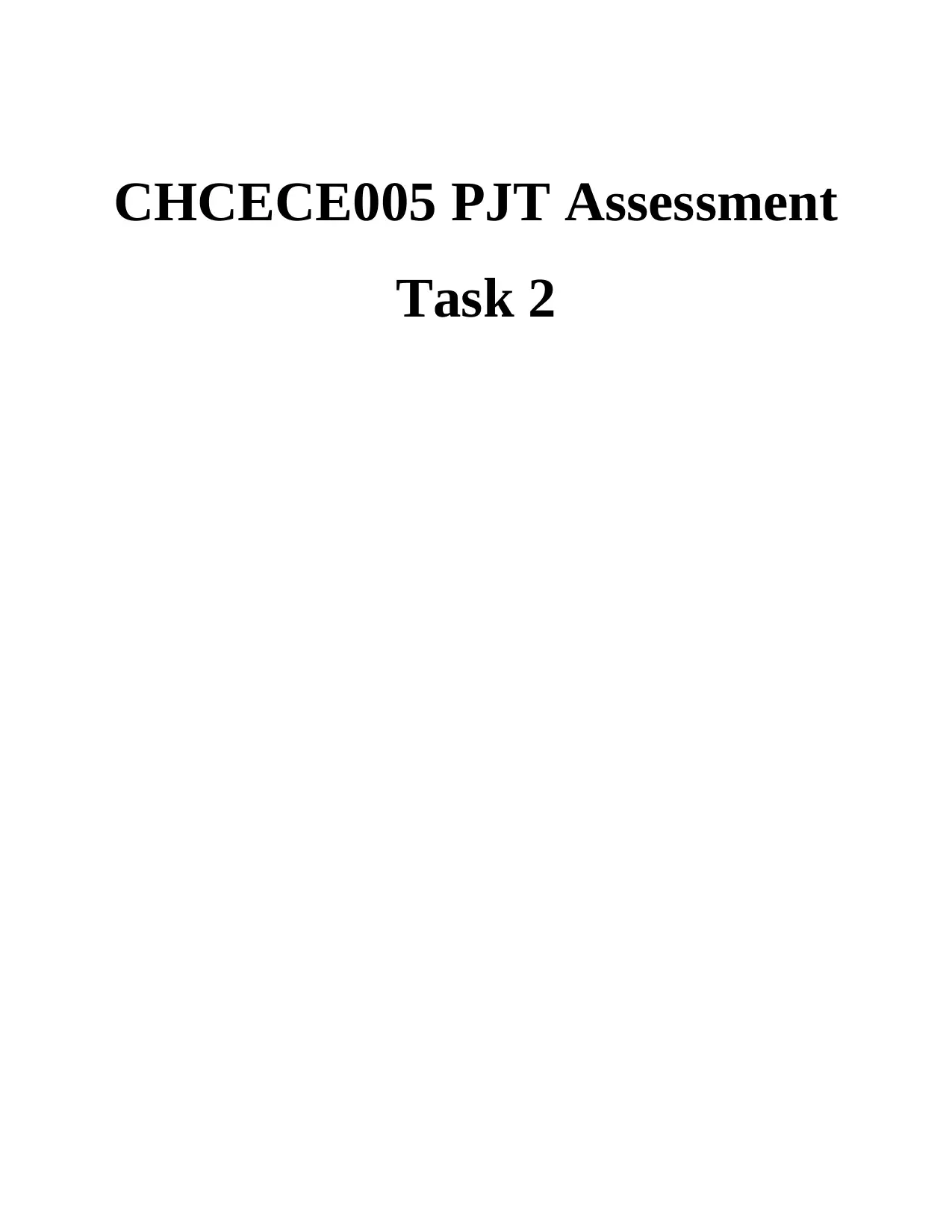
CHCECE005 PJT Assessment
Task 2
Task 2
Paraphrase This Document
Need a fresh take? Get an instant paraphrase of this document with our AI Paraphraser
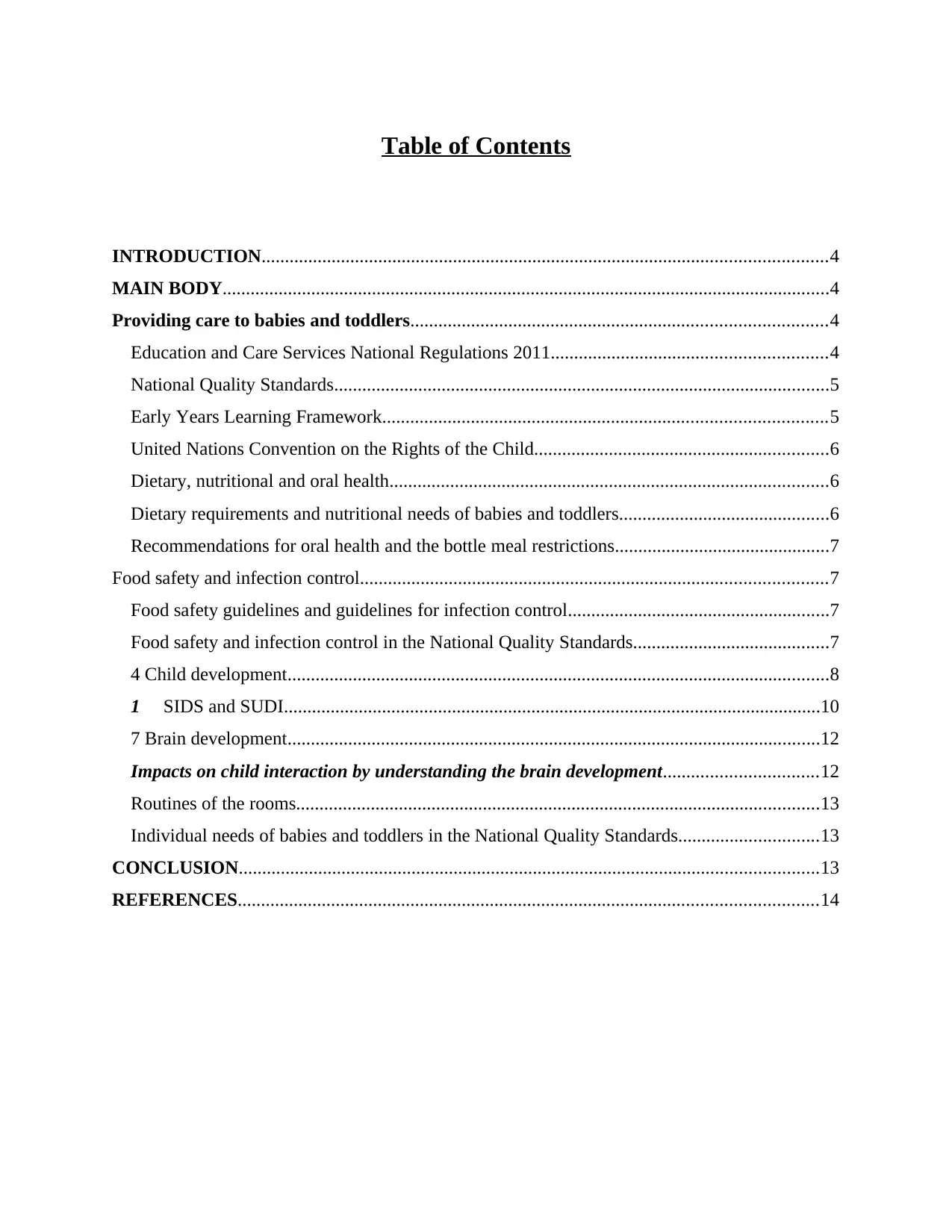
Table of Contents
INTRODUCTION.........................................................................................................................4
MAIN BODY..................................................................................................................................4
Providing care to babies and toddlers.........................................................................................4
Education and Care Services National Regulations 2011...........................................................4
National Quality Standards..........................................................................................................5
Early Years Learning Framework...............................................................................................5
United Nations Convention on the Rights of the Child...............................................................6
Dietary, nutritional and oral health..............................................................................................6
Dietary requirements and nutritional needs of babies and toddlers.............................................6
Recommendations for oral health and the bottle meal restrictions..............................................7
Food safety and infection control....................................................................................................7
Food safety guidelines and guidelines for infection control........................................................7
Food safety and infection control in the National Quality Standards..........................................7
4 Child development....................................................................................................................8
1 SIDS and SUDI...................................................................................................................10
7 Brain development..................................................................................................................12
Impacts on child interaction by understanding the brain development.................................12
Routines of the rooms................................................................................................................13
Individual needs of babies and toddlers in the National Quality Standards..............................13
CONCLUSION............................................................................................................................13
REFERENCES............................................................................................................................14
INTRODUCTION.........................................................................................................................4
MAIN BODY..................................................................................................................................4
Providing care to babies and toddlers.........................................................................................4
Education and Care Services National Regulations 2011...........................................................4
National Quality Standards..........................................................................................................5
Early Years Learning Framework...............................................................................................5
United Nations Convention on the Rights of the Child...............................................................6
Dietary, nutritional and oral health..............................................................................................6
Dietary requirements and nutritional needs of babies and toddlers.............................................6
Recommendations for oral health and the bottle meal restrictions..............................................7
Food safety and infection control....................................................................................................7
Food safety guidelines and guidelines for infection control........................................................7
Food safety and infection control in the National Quality Standards..........................................7
4 Child development....................................................................................................................8
1 SIDS and SUDI...................................................................................................................10
7 Brain development..................................................................................................................12
Impacts on child interaction by understanding the brain development.................................12
Routines of the rooms................................................................................................................13
Individual needs of babies and toddlers in the National Quality Standards..............................13
CONCLUSION............................................................................................................................13
REFERENCES............................................................................................................................14

⊘ This is a preview!⊘
Do you want full access?
Subscribe today to unlock all pages.

Trusted by 1+ million students worldwide

Paraphrase This Document
Need a fresh take? Get an instant paraphrase of this document with our AI Paraphraser
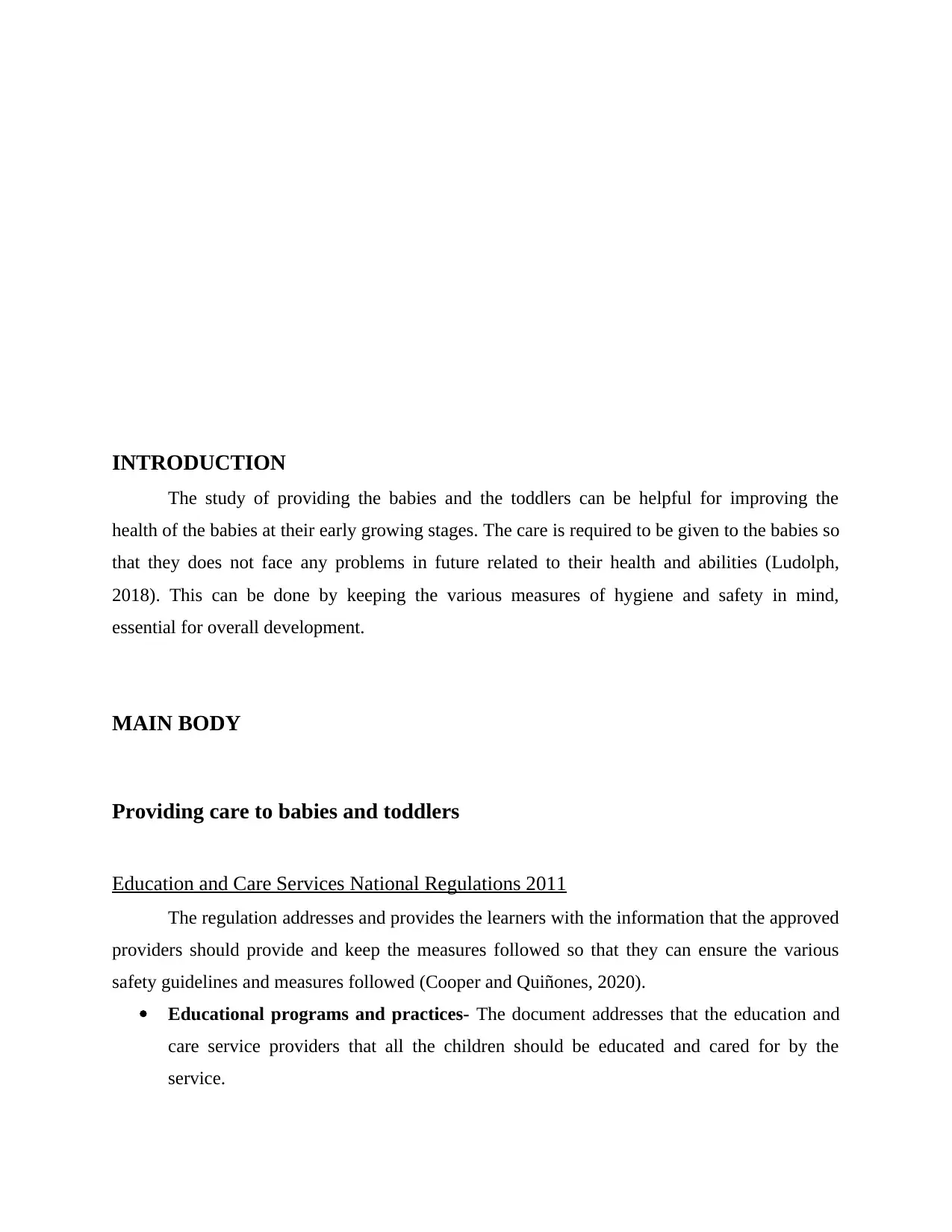
INTRODUCTION
The study of providing the babies and the toddlers can be helpful for improving the
health of the babies at their early growing stages. The care is required to be given to the babies so
that they does not face any problems in future related to their health and abilities (Ludolph,
2018). This can be done by keeping the various measures of hygiene and safety in mind,
essential for overall development.
MAIN BODY
Providing care to babies and toddlers
Education and Care Services National Regulations 2011
The regulation addresses and provides the learners with the information that the approved
providers should provide and keep the measures followed so that they can ensure the various
safety guidelines and measures followed (Cooper and Quiñones, 2020).
Educational programs and practices- The document addresses that the education and
care service providers that all the children should be educated and cared for by the
service.
The study of providing the babies and the toddlers can be helpful for improving the
health of the babies at their early growing stages. The care is required to be given to the babies so
that they does not face any problems in future related to their health and abilities (Ludolph,
2018). This can be done by keeping the various measures of hygiene and safety in mind,
essential for overall development.
MAIN BODY
Providing care to babies and toddlers
Education and Care Services National Regulations 2011
The regulation addresses and provides the learners with the information that the approved
providers should provide and keep the measures followed so that they can ensure the various
safety guidelines and measures followed (Cooper and Quiñones, 2020).
Educational programs and practices- The document addresses that the education and
care service providers that all the children should be educated and cared for by the
service.
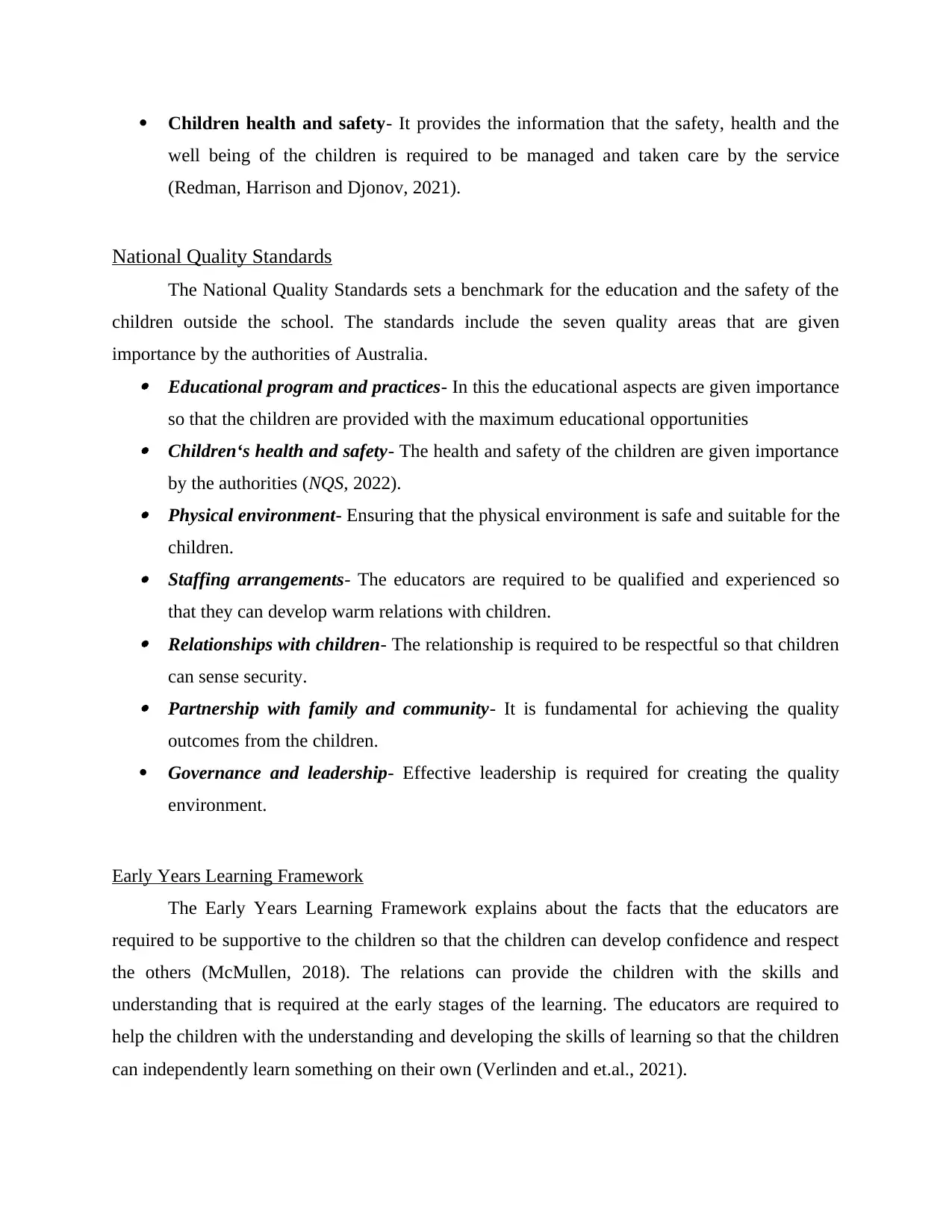
Children health and safety- It provides the information that the safety, health and the
well being of the children is required to be managed and taken care by the service
(Redman, Harrison and Djonov, 2021).
National Quality Standards
The National Quality Standards sets a benchmark for the education and the safety of the
children outside the school. The standards include the seven quality areas that are given
importance by the authorities of Australia. Educational program and practices- In this the educational aspects are given importance
so that the children are provided with the maximum educational opportunities Children‘s health and safety- The health and safety of the children are given importance
by the authorities (NQS, 2022). Physical environment- Ensuring that the physical environment is safe and suitable for the
children. Staffing arrangements- The educators are required to be qualified and experienced so
that they can develop warm relations with children. Relationships with children- The relationship is required to be respectful so that children
can sense security. Partnership with family and community- It is fundamental for achieving the quality
outcomes from the children.
Governance and leadership- Effective leadership is required for creating the quality
environment.
Early Years Learning Framework
The Early Years Learning Framework explains about the facts that the educators are
required to be supportive to the children so that the children can develop confidence and respect
the others (McMullen, 2018). The relations can provide the children with the skills and
understanding that is required at the early stages of the learning. The educators are required to
help the children with the understanding and developing the skills of learning so that the children
can independently learn something on their own (Verlinden and et.al., 2021).
well being of the children is required to be managed and taken care by the service
(Redman, Harrison and Djonov, 2021).
National Quality Standards
The National Quality Standards sets a benchmark for the education and the safety of the
children outside the school. The standards include the seven quality areas that are given
importance by the authorities of Australia. Educational program and practices- In this the educational aspects are given importance
so that the children are provided with the maximum educational opportunities Children‘s health and safety- The health and safety of the children are given importance
by the authorities (NQS, 2022). Physical environment- Ensuring that the physical environment is safe and suitable for the
children. Staffing arrangements- The educators are required to be qualified and experienced so
that they can develop warm relations with children. Relationships with children- The relationship is required to be respectful so that children
can sense security. Partnership with family and community- It is fundamental for achieving the quality
outcomes from the children.
Governance and leadership- Effective leadership is required for creating the quality
environment.
Early Years Learning Framework
The Early Years Learning Framework explains about the facts that the educators are
required to be supportive to the children so that the children can develop confidence and respect
the others (McMullen, 2018). The relations can provide the children with the skills and
understanding that is required at the early stages of the learning. The educators are required to
help the children with the understanding and developing the skills of learning so that the children
can independently learn something on their own (Verlinden and et.al., 2021).
⊘ This is a preview!⊘
Do you want full access?
Subscribe today to unlock all pages.

Trusted by 1+ million students worldwide
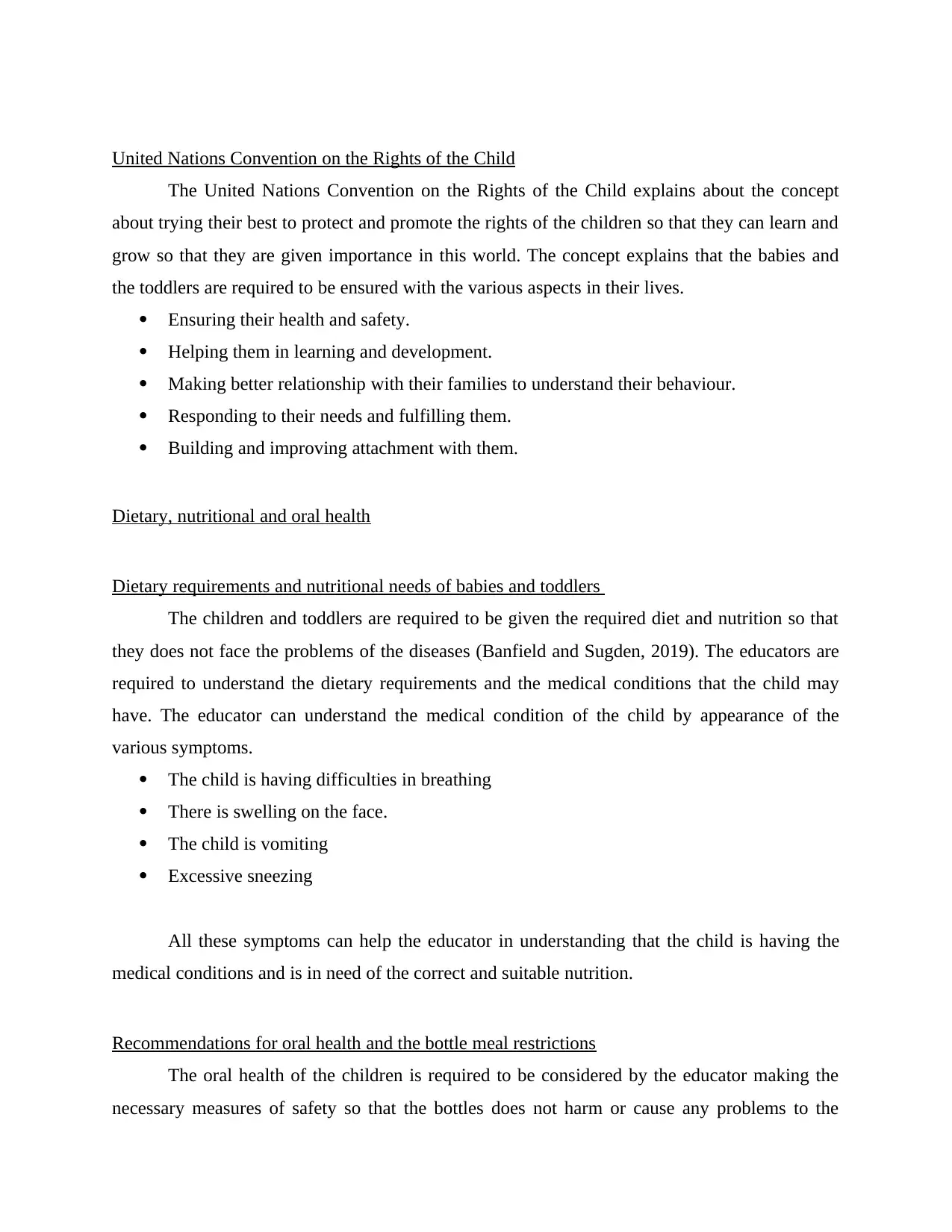
United Nations Convention on the Rights of the Child
The United Nations Convention on the Rights of the Child explains about the concept
about trying their best to protect and promote the rights of the children so that they can learn and
grow so that they are given importance in this world. The concept explains that the babies and
the toddlers are required to be ensured with the various aspects in their lives.
Ensuring their health and safety.
Helping them in learning and development.
Making better relationship with their families to understand their behaviour.
Responding to their needs and fulfilling them.
Building and improving attachment with them.
Dietary, nutritional and oral health
Dietary requirements and nutritional needs of babies and toddlers
The children and toddlers are required to be given the required diet and nutrition so that
they does not face the problems of the diseases (Banfield and Sugden, 2019). The educators are
required to understand the dietary requirements and the medical conditions that the child may
have. The educator can understand the medical condition of the child by appearance of the
various symptoms.
The child is having difficulties in breathing
There is swelling on the face.
The child is vomiting
Excessive sneezing
All these symptoms can help the educator in understanding that the child is having the
medical conditions and is in need of the correct and suitable nutrition.
Recommendations for oral health and the bottle meal restrictions
The oral health of the children is required to be considered by the educator making the
necessary measures of safety so that the bottles does not harm or cause any problems to the
The United Nations Convention on the Rights of the Child explains about the concept
about trying their best to protect and promote the rights of the children so that they can learn and
grow so that they are given importance in this world. The concept explains that the babies and
the toddlers are required to be ensured with the various aspects in their lives.
Ensuring their health and safety.
Helping them in learning and development.
Making better relationship with their families to understand their behaviour.
Responding to their needs and fulfilling them.
Building and improving attachment with them.
Dietary, nutritional and oral health
Dietary requirements and nutritional needs of babies and toddlers
The children and toddlers are required to be given the required diet and nutrition so that
they does not face the problems of the diseases (Banfield and Sugden, 2019). The educators are
required to understand the dietary requirements and the medical conditions that the child may
have. The educator can understand the medical condition of the child by appearance of the
various symptoms.
The child is having difficulties in breathing
There is swelling on the face.
The child is vomiting
Excessive sneezing
All these symptoms can help the educator in understanding that the child is having the
medical conditions and is in need of the correct and suitable nutrition.
Recommendations for oral health and the bottle meal restrictions
The oral health of the children is required to be considered by the educator making the
necessary measures of safety so that the bottles does not harm or cause any problems to the
Paraphrase This Document
Need a fresh take? Get an instant paraphrase of this document with our AI Paraphraser
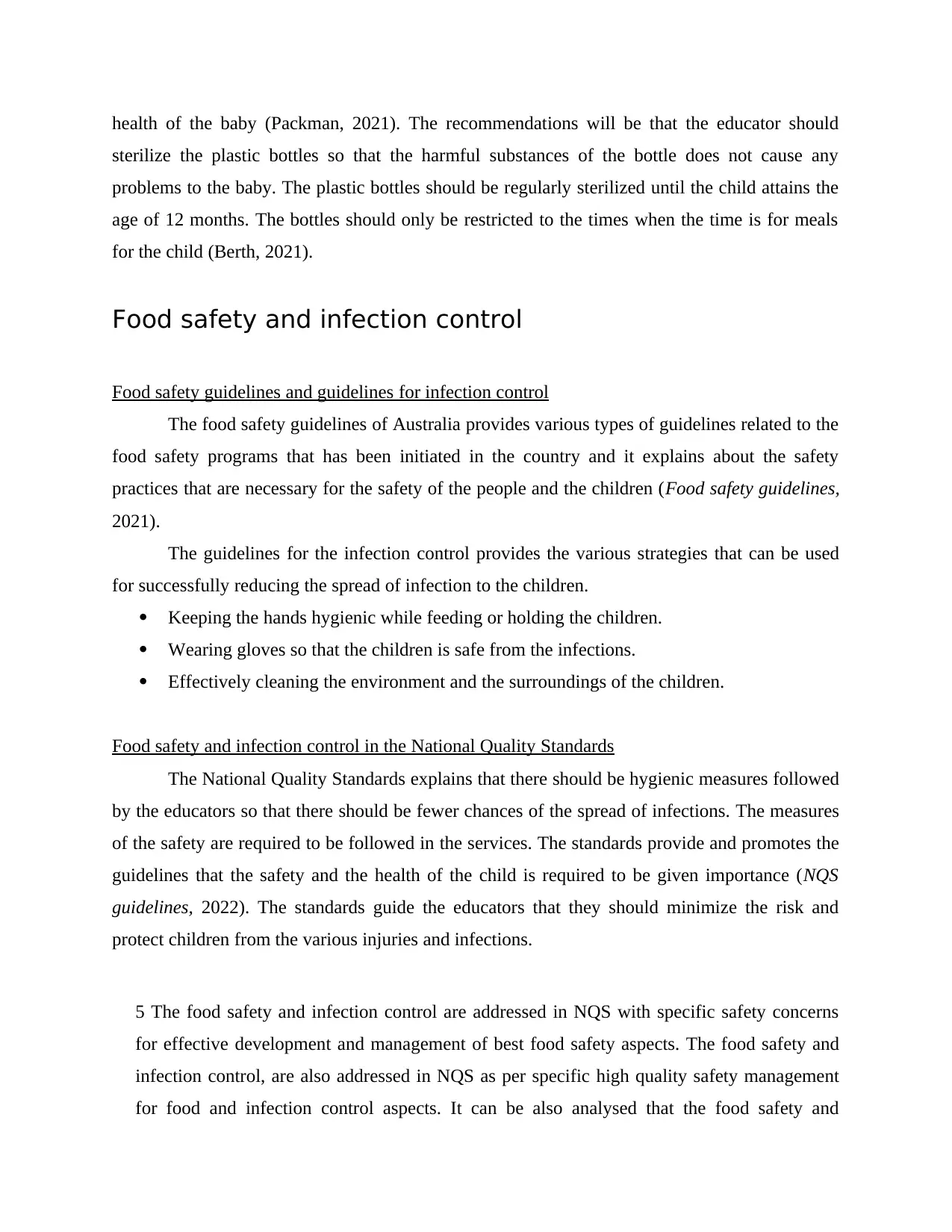
health of the baby (Packman, 2021). The recommendations will be that the educator should
sterilize the plastic bottles so that the harmful substances of the bottle does not cause any
problems to the baby. The plastic bottles should be regularly sterilized until the child attains the
age of 12 months. The bottles should only be restricted to the times when the time is for meals
for the child (Berth, 2021).
Food safety and infection control
Food safety guidelines and guidelines for infection control
The food safety guidelines of Australia provides various types of guidelines related to the
food safety programs that has been initiated in the country and it explains about the safety
practices that are necessary for the safety of the people and the children (Food safety guidelines,
2021).
The guidelines for the infection control provides the various strategies that can be used
for successfully reducing the spread of infection to the children.
Keeping the hands hygienic while feeding or holding the children.
Wearing gloves so that the children is safe from the infections.
Effectively cleaning the environment and the surroundings of the children.
Food safety and infection control in the National Quality Standards
The National Quality Standards explains that there should be hygienic measures followed
by the educators so that there should be fewer chances of the spread of infections. The measures
of the safety are required to be followed in the services. The standards provide and promotes the
guidelines that the safety and the health of the child is required to be given importance (NQS
guidelines, 2022). The standards guide the educators that they should minimize the risk and
protect children from the various injuries and infections.
5 The food safety and infection control are addressed in NQS with specific safety concerns
for effective development and management of best food safety aspects. The food safety and
infection control, are also addressed in NQS as per specific high quality safety management
for food and infection control aspects. It can be also analysed that the food safety and
sterilize the plastic bottles so that the harmful substances of the bottle does not cause any
problems to the baby. The plastic bottles should be regularly sterilized until the child attains the
age of 12 months. The bottles should only be restricted to the times when the time is for meals
for the child (Berth, 2021).
Food safety and infection control
Food safety guidelines and guidelines for infection control
The food safety guidelines of Australia provides various types of guidelines related to the
food safety programs that has been initiated in the country and it explains about the safety
practices that are necessary for the safety of the people and the children (Food safety guidelines,
2021).
The guidelines for the infection control provides the various strategies that can be used
for successfully reducing the spread of infection to the children.
Keeping the hands hygienic while feeding or holding the children.
Wearing gloves so that the children is safe from the infections.
Effectively cleaning the environment and the surroundings of the children.
Food safety and infection control in the National Quality Standards
The National Quality Standards explains that there should be hygienic measures followed
by the educators so that there should be fewer chances of the spread of infections. The measures
of the safety are required to be followed in the services. The standards provide and promotes the
guidelines that the safety and the health of the child is required to be given importance (NQS
guidelines, 2022). The standards guide the educators that they should minimize the risk and
protect children from the various injuries and infections.
5 The food safety and infection control are addressed in NQS with specific safety concerns
for effective development and management of best food safety aspects. The food safety and
infection control, are also addressed in NQS as per specific high quality safety management
for food and infection control aspects. It can be also analysed that the food safety and
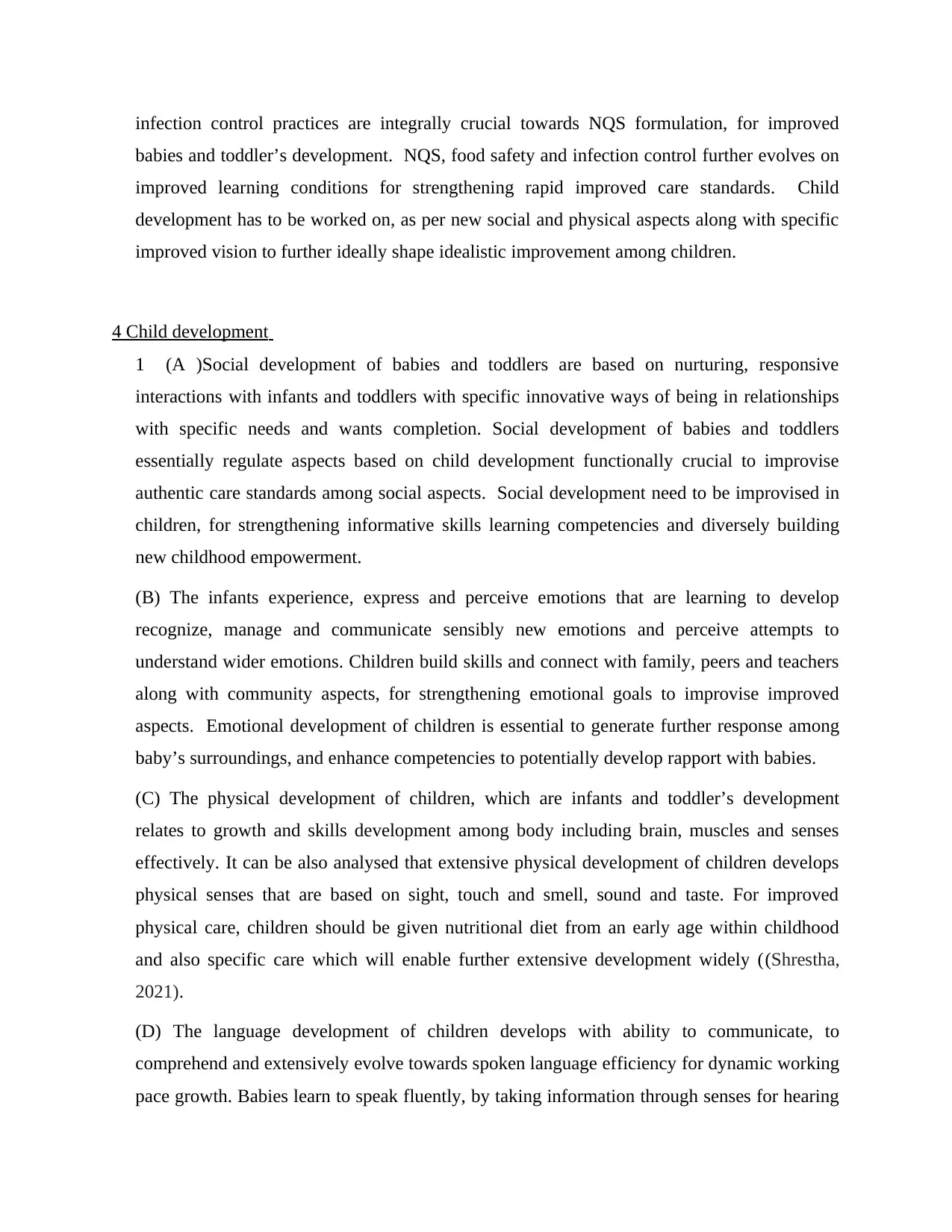
infection control practices are integrally crucial towards NQS formulation, for improved
babies and toddler’s development. NQS, food safety and infection control further evolves on
improved learning conditions for strengthening rapid improved care standards. Child
development has to be worked on, as per new social and physical aspects along with specific
improved vision to further ideally shape idealistic improvement among children.
4 Child development
1 (A )Social development of babies and toddlers are based on nurturing, responsive
interactions with infants and toddlers with specific innovative ways of being in relationships
with specific needs and wants completion. Social development of babies and toddlers
essentially regulate aspects based on child development functionally crucial to improvise
authentic care standards among social aspects. Social development need to be improvised in
children, for strengthening informative skills learning competencies and diversely building
new childhood empowerment.
(B) The infants experience, express and perceive emotions that are learning to develop
recognize, manage and communicate sensibly new emotions and perceive attempts to
understand wider emotions. Children build skills and connect with family, peers and teachers
along with community aspects, for strengthening emotional goals to improvise improved
aspects. Emotional development of children is essential to generate further response among
baby’s surroundings, and enhance competencies to potentially develop rapport with babies.
(C) The physical development of children, which are infants and toddler’s development
relates to growth and skills development among body including brain, muscles and senses
effectively. It can be also analysed that extensive physical development of children develops
physical senses that are based on sight, touch and smell, sound and taste. For improved
physical care, children should be given nutritional diet from an early age within childhood
and also specific care which will enable further extensive development widely ((Shrestha,
2021).
(D) The language development of children develops with ability to communicate, to
comprehend and extensively evolve towards spoken language efficiency for dynamic working
pace growth. Babies learn to speak fluently, by taking information through senses for hearing
babies and toddler’s development. NQS, food safety and infection control further evolves on
improved learning conditions for strengthening rapid improved care standards. Child
development has to be worked on, as per new social and physical aspects along with specific
improved vision to further ideally shape idealistic improvement among children.
4 Child development
1 (A )Social development of babies and toddlers are based on nurturing, responsive
interactions with infants and toddlers with specific innovative ways of being in relationships
with specific needs and wants completion. Social development of babies and toddlers
essentially regulate aspects based on child development functionally crucial to improvise
authentic care standards among social aspects. Social development need to be improvised in
children, for strengthening informative skills learning competencies and diversely building
new childhood empowerment.
(B) The infants experience, express and perceive emotions that are learning to develop
recognize, manage and communicate sensibly new emotions and perceive attempts to
understand wider emotions. Children build skills and connect with family, peers and teachers
along with community aspects, for strengthening emotional goals to improvise improved
aspects. Emotional development of children is essential to generate further response among
baby’s surroundings, and enhance competencies to potentially develop rapport with babies.
(C) The physical development of children, which are infants and toddler’s development
relates to growth and skills development among body including brain, muscles and senses
effectively. It can be also analysed that extensive physical development of children develops
physical senses that are based on sight, touch and smell, sound and taste. For improved
physical care, children should be given nutritional diet from an early age within childhood
and also specific care which will enable further extensive development widely ((Shrestha,
2021).
(D) The language development of children develops with ability to communicate, to
comprehend and extensively evolve towards spoken language efficiency for dynamic working
pace growth. Babies learn to speak fluently, by taking information through senses for hearing
⊘ This is a preview!⊘
Do you want full access?
Subscribe today to unlock all pages.

Trusted by 1+ million students worldwide
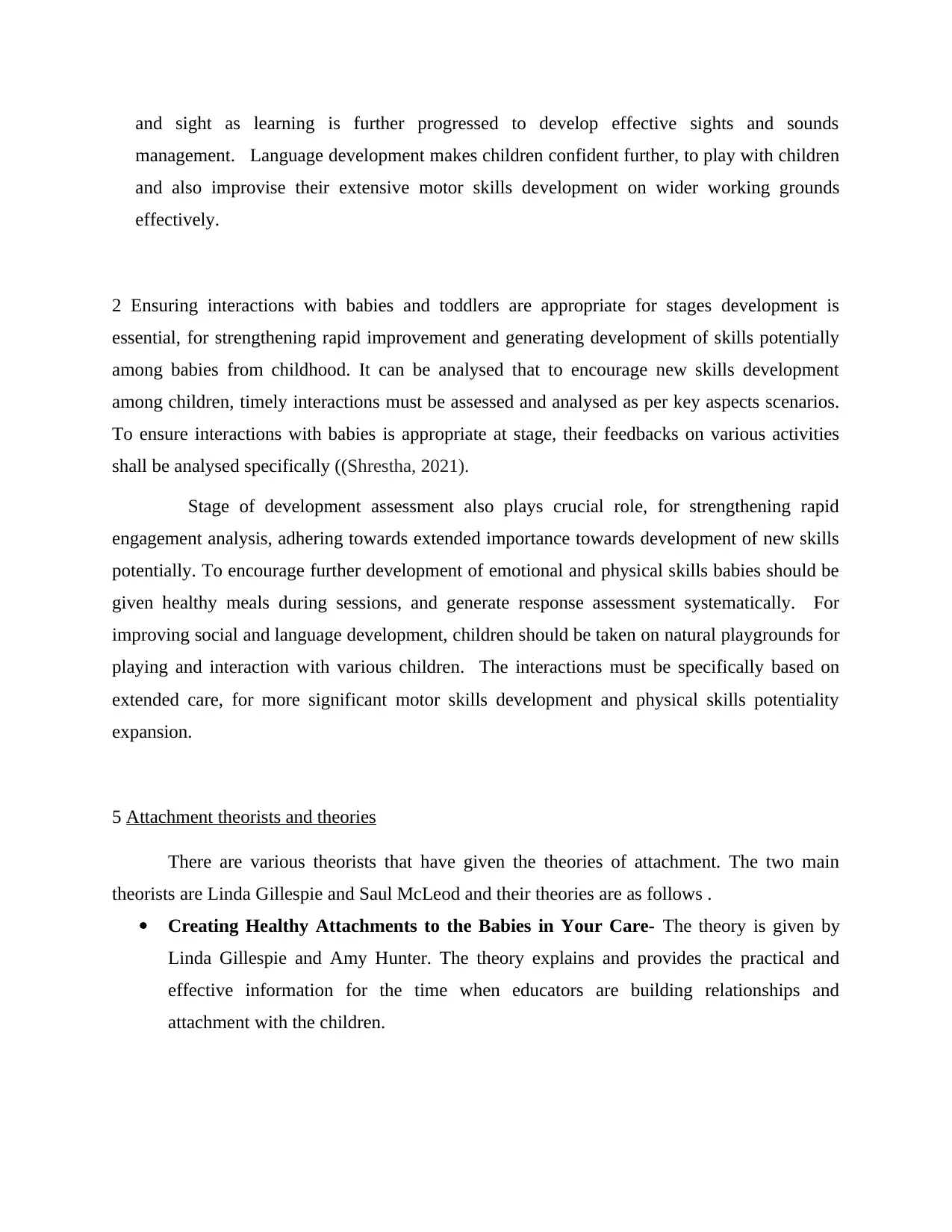
and sight as learning is further progressed to develop effective sights and sounds
management. Language development makes children confident further, to play with children
and also improvise their extensive motor skills development on wider working grounds
effectively.
2 Ensuring interactions with babies and toddlers are appropriate for stages development is
essential, for strengthening rapid improvement and generating development of skills potentially
among babies from childhood. It can be analysed that to encourage new skills development
among children, timely interactions must be assessed and analysed as per key aspects scenarios.
To ensure interactions with babies is appropriate at stage, their feedbacks on various activities
shall be analysed specifically ((Shrestha, 2021).
Stage of development assessment also plays crucial role, for strengthening rapid
engagement analysis, adhering towards extended importance towards development of new skills
potentially. To encourage further development of emotional and physical skills babies should be
given healthy meals during sessions, and generate response assessment systematically. For
improving social and language development, children should be taken on natural playgrounds for
playing and interaction with various children. The interactions must be specifically based on
extended care, for more significant motor skills development and physical skills potentiality
expansion.
5 Attachment theorists and theories
There are various theorists that have given the theories of attachment. The two main
theorists are Linda Gillespie and Saul McLeod and their theories are as follows .
Creating Healthy Attachments to the Babies in Your Care- The theory is given by
Linda Gillespie and Amy Hunter. The theory explains and provides the practical and
effective information for the time when educators are building relationships and
attachment with the children.
management. Language development makes children confident further, to play with children
and also improvise their extensive motor skills development on wider working grounds
effectively.
2 Ensuring interactions with babies and toddlers are appropriate for stages development is
essential, for strengthening rapid improvement and generating development of skills potentially
among babies from childhood. It can be analysed that to encourage new skills development
among children, timely interactions must be assessed and analysed as per key aspects scenarios.
To ensure interactions with babies is appropriate at stage, their feedbacks on various activities
shall be analysed specifically ((Shrestha, 2021).
Stage of development assessment also plays crucial role, for strengthening rapid
engagement analysis, adhering towards extended importance towards development of new skills
potentially. To encourage further development of emotional and physical skills babies should be
given healthy meals during sessions, and generate response assessment systematically. For
improving social and language development, children should be taken on natural playgrounds for
playing and interaction with various children. The interactions must be specifically based on
extended care, for more significant motor skills development and physical skills potentiality
expansion.
5 Attachment theorists and theories
There are various theorists that have given the theories of attachment. The two main
theorists are Linda Gillespie and Saul McLeod and their theories are as follows .
Creating Healthy Attachments to the Babies in Your Care- The theory is given by
Linda Gillespie and Amy Hunter. The theory explains and provides the practical and
effective information for the time when educators are building relationships and
attachment with the children.
Paraphrase This Document
Need a fresh take? Get an instant paraphrase of this document with our AI Paraphraser
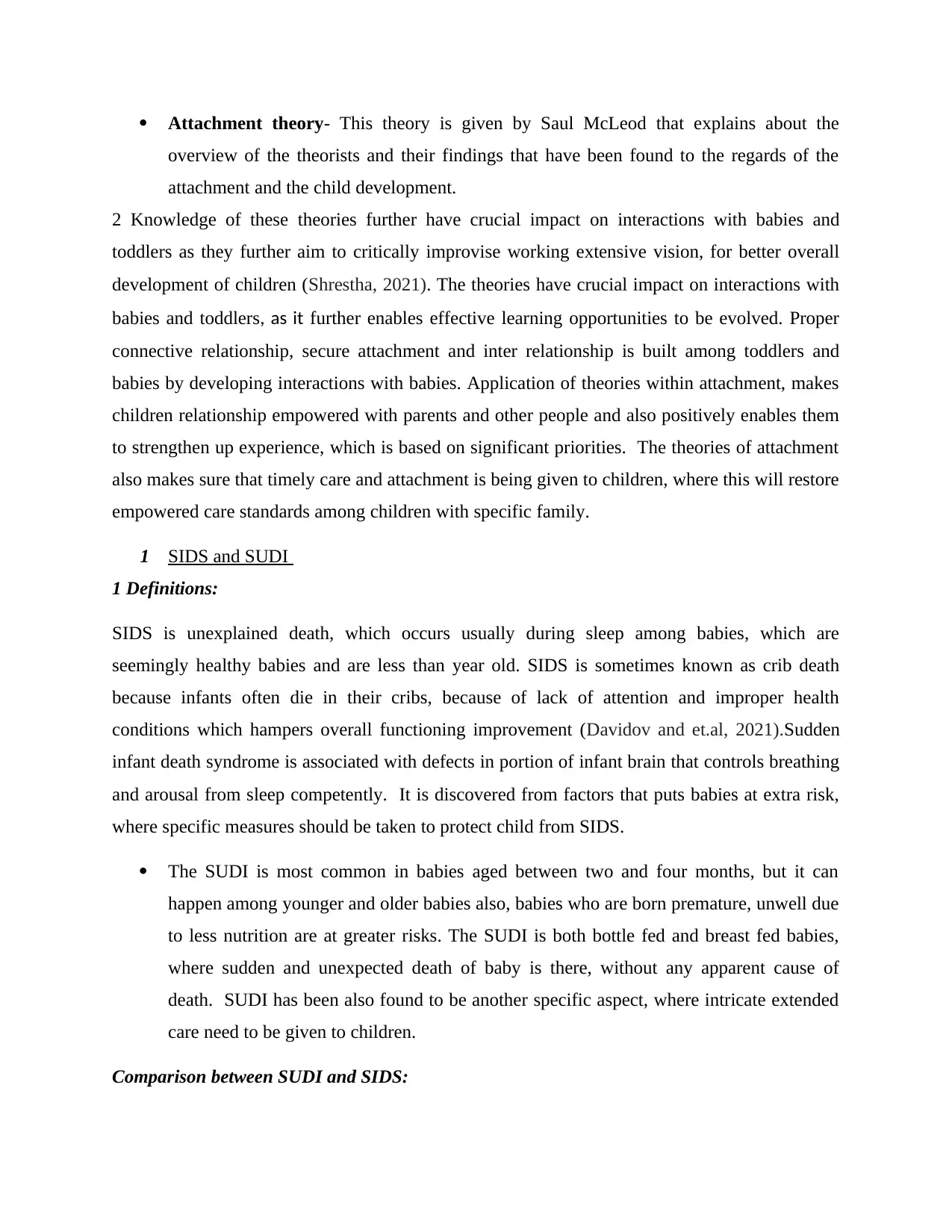
Attachment theory- This theory is given by Saul McLeod that explains about the
overview of the theorists and their findings that have been found to the regards of the
attachment and the child development.
2 Knowledge of these theories further have crucial impact on interactions with babies and
toddlers as they further aim to critically improvise working extensive vision, for better overall
development of children (Shrestha, 2021). The theories have crucial impact on interactions with
babies and toddlers, as it further enables effective learning opportunities to be evolved. Proper
connective relationship, secure attachment and inter relationship is built among toddlers and
babies by developing interactions with babies. Application of theories within attachment, makes
children relationship empowered with parents and other people and also positively enables them
to strengthen up experience, which is based on significant priorities. The theories of attachment
also makes sure that timely care and attachment is being given to children, where this will restore
empowered care standards among children with specific family.
1 SIDS and SUDI
1 Definitions:
SIDS is unexplained death, which occurs usually during sleep among babies, which are
seemingly healthy babies and are less than year old. SIDS is sometimes known as crib death
because infants often die in their cribs, because of lack of attention and improper health
conditions which hampers overall functioning improvement (Davidov and et.al, 2021).Sudden
infant death syndrome is associated with defects in portion of infant brain that controls breathing
and arousal from sleep competently. It is discovered from factors that puts babies at extra risk,
where specific measures should be taken to protect child from SIDS.
The SUDI is most common in babies aged between two and four months, but it can
happen among younger and older babies also, babies who are born premature, unwell due
to less nutrition are at greater risks. The SUDI is both bottle fed and breast fed babies,
where sudden and unexpected death of baby is there, without any apparent cause of
death. SUDI has been also found to be another specific aspect, where intricate extended
care need to be given to children.
Comparison between SUDI and SIDS:
overview of the theorists and their findings that have been found to the regards of the
attachment and the child development.
2 Knowledge of these theories further have crucial impact on interactions with babies and
toddlers as they further aim to critically improvise working extensive vision, for better overall
development of children (Shrestha, 2021). The theories have crucial impact on interactions with
babies and toddlers, as it further enables effective learning opportunities to be evolved. Proper
connective relationship, secure attachment and inter relationship is built among toddlers and
babies by developing interactions with babies. Application of theories within attachment, makes
children relationship empowered with parents and other people and also positively enables them
to strengthen up experience, which is based on significant priorities. The theories of attachment
also makes sure that timely care and attachment is being given to children, where this will restore
empowered care standards among children with specific family.
1 SIDS and SUDI
1 Definitions:
SIDS is unexplained death, which occurs usually during sleep among babies, which are
seemingly healthy babies and are less than year old. SIDS is sometimes known as crib death
because infants often die in their cribs, because of lack of attention and improper health
conditions which hampers overall functioning improvement (Davidov and et.al, 2021).Sudden
infant death syndrome is associated with defects in portion of infant brain that controls breathing
and arousal from sleep competently. It is discovered from factors that puts babies at extra risk,
where specific measures should be taken to protect child from SIDS.
The SUDI is most common in babies aged between two and four months, but it can
happen among younger and older babies also, babies who are born premature, unwell due
to less nutrition are at greater risks. The SUDI is both bottle fed and breast fed babies,
where sudden and unexpected death of baby is there, without any apparent cause of
death. SUDI has been also found to be another specific aspect, where intricate extended
care need to be given to children.
Comparison between SUDI and SIDS:
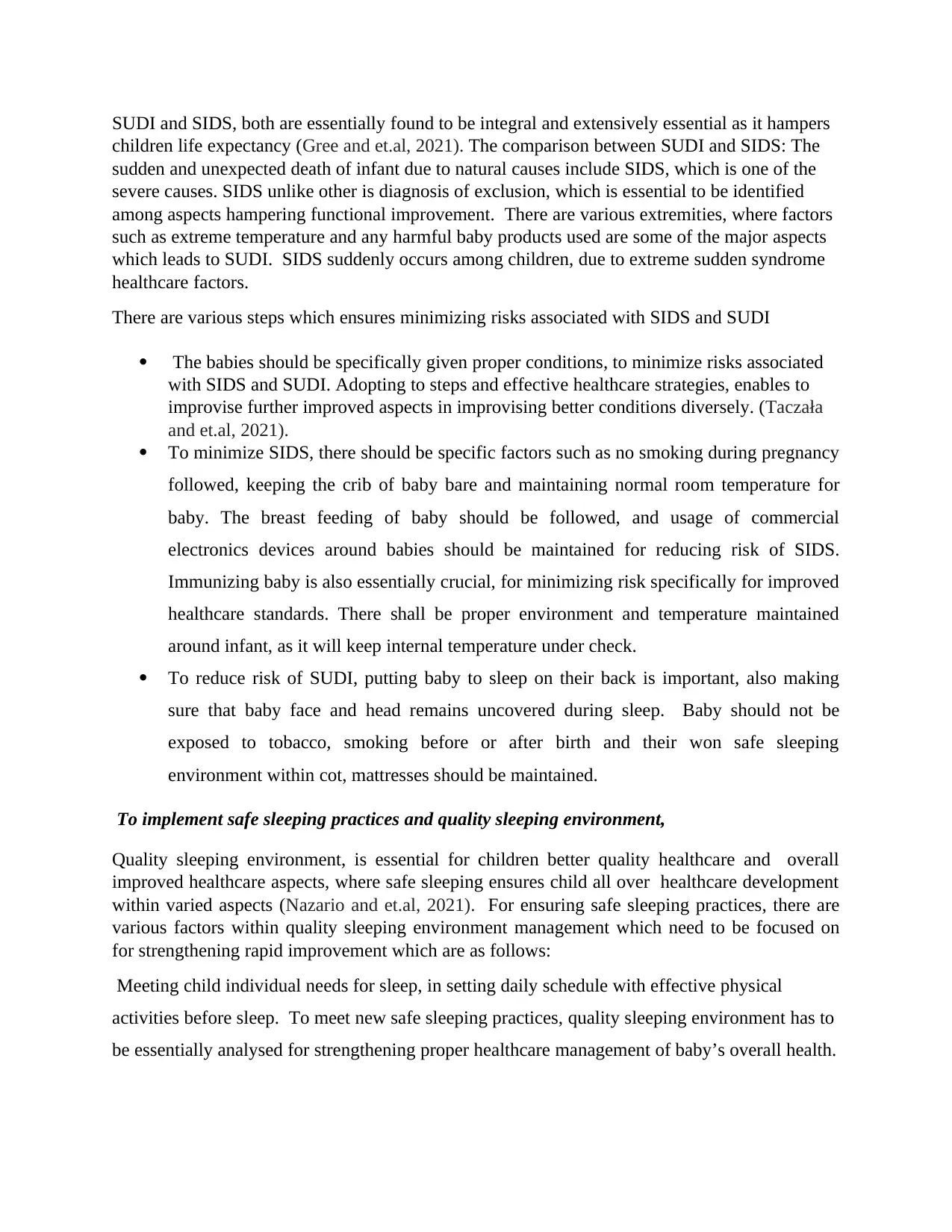
SUDI and SIDS, both are essentially found to be integral and extensively essential as it hampers
children life expectancy (Gree and et.al, 2021). The comparison between SUDI and SIDS: The
sudden and unexpected death of infant due to natural causes include SIDS, which is one of the
severe causes. SIDS unlike other is diagnosis of exclusion, which is essential to be identified
among aspects hampering functional improvement. There are various extremities, where factors
such as extreme temperature and any harmful baby products used are some of the major aspects
which leads to SUDI. SIDS suddenly occurs among children, due to extreme sudden syndrome
healthcare factors.
There are various steps which ensures minimizing risks associated with SIDS and SUDI
The babies should be specifically given proper conditions, to minimize risks associated
with SIDS and SUDI. Adopting to steps and effective healthcare strategies, enables to
improvise further improved aspects in improvising better conditions diversely. (Taczała
and et.al, 2021).
To minimize SIDS, there should be specific factors such as no smoking during pregnancy
followed, keeping the crib of baby bare and maintaining normal room temperature for
baby. The breast feeding of baby should be followed, and usage of commercial
electronics devices around babies should be maintained for reducing risk of SIDS.
Immunizing baby is also essentially crucial, for minimizing risk specifically for improved
healthcare standards. There shall be proper environment and temperature maintained
around infant, as it will keep internal temperature under check.
To reduce risk of SUDI, putting baby to sleep on their back is important, also making
sure that baby face and head remains uncovered during sleep. Baby should not be
exposed to tobacco, smoking before or after birth and their won safe sleeping
environment within cot, mattresses should be maintained.
To implement safe sleeping practices and quality sleeping environment,
Quality sleeping environment, is essential for children better quality healthcare and overall
improved healthcare aspects, where safe sleeping ensures child all over healthcare development
within varied aspects (Nazario and et.al, 2021). For ensuring safe sleeping practices, there are
various factors within quality sleeping environment management which need to be focused on
for strengthening rapid improvement which are as follows:
Meeting child individual needs for sleep, in setting daily schedule with effective physical
activities before sleep. To meet new safe sleeping practices, quality sleeping environment has to
be essentially analysed for strengthening proper healthcare management of baby’s overall health.
children life expectancy (Gree and et.al, 2021). The comparison between SUDI and SIDS: The
sudden and unexpected death of infant due to natural causes include SIDS, which is one of the
severe causes. SIDS unlike other is diagnosis of exclusion, which is essential to be identified
among aspects hampering functional improvement. There are various extremities, where factors
such as extreme temperature and any harmful baby products used are some of the major aspects
which leads to SUDI. SIDS suddenly occurs among children, due to extreme sudden syndrome
healthcare factors.
There are various steps which ensures minimizing risks associated with SIDS and SUDI
The babies should be specifically given proper conditions, to minimize risks associated
with SIDS and SUDI. Adopting to steps and effective healthcare strategies, enables to
improvise further improved aspects in improvising better conditions diversely. (Taczała
and et.al, 2021).
To minimize SIDS, there should be specific factors such as no smoking during pregnancy
followed, keeping the crib of baby bare and maintaining normal room temperature for
baby. The breast feeding of baby should be followed, and usage of commercial
electronics devices around babies should be maintained for reducing risk of SIDS.
Immunizing baby is also essentially crucial, for minimizing risk specifically for improved
healthcare standards. There shall be proper environment and temperature maintained
around infant, as it will keep internal temperature under check.
To reduce risk of SUDI, putting baby to sleep on their back is important, also making
sure that baby face and head remains uncovered during sleep. Baby should not be
exposed to tobacco, smoking before or after birth and their won safe sleeping
environment within cot, mattresses should be maintained.
To implement safe sleeping practices and quality sleeping environment,
Quality sleeping environment, is essential for children better quality healthcare and overall
improved healthcare aspects, where safe sleeping ensures child all over healthcare development
within varied aspects (Nazario and et.al, 2021). For ensuring safe sleeping practices, there are
various factors within quality sleeping environment management which need to be focused on
for strengthening rapid improvement which are as follows:
Meeting child individual needs for sleep, in setting daily schedule with effective physical
activities before sleep. To meet new safe sleeping practices, quality sleeping environment has to
be essentially analysed for strengthening proper healthcare management of baby’s overall health.
⊘ This is a preview!⊘
Do you want full access?
Subscribe today to unlock all pages.

Trusted by 1+ million students worldwide
1 out of 17
Related Documents
Your All-in-One AI-Powered Toolkit for Academic Success.
+13062052269
info@desklib.com
Available 24*7 on WhatsApp / Email
![[object Object]](/_next/static/media/star-bottom.7253800d.svg)
Unlock your academic potential
Copyright © 2020–2025 A2Z Services. All Rights Reserved. Developed and managed by ZUCOL.





